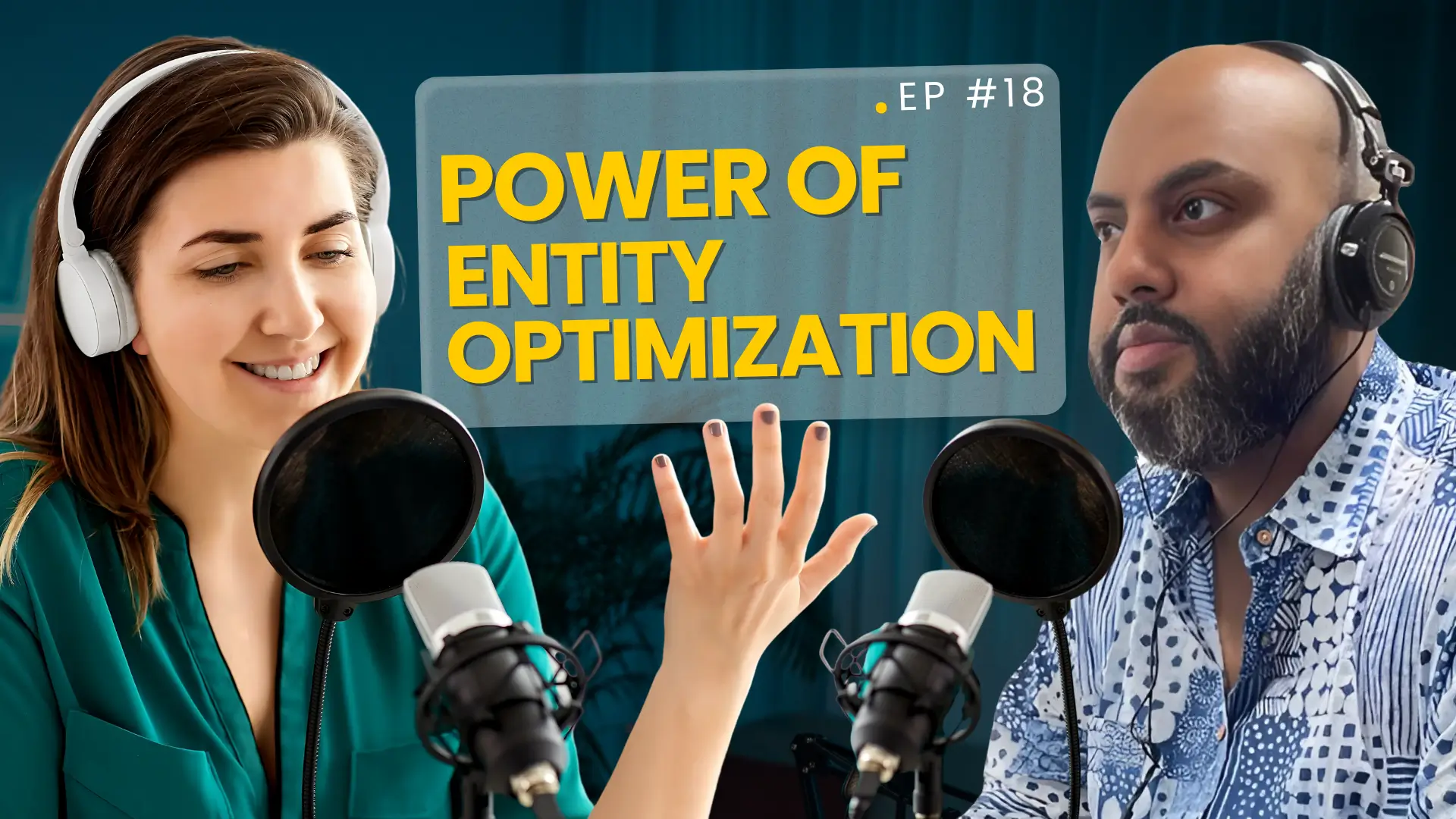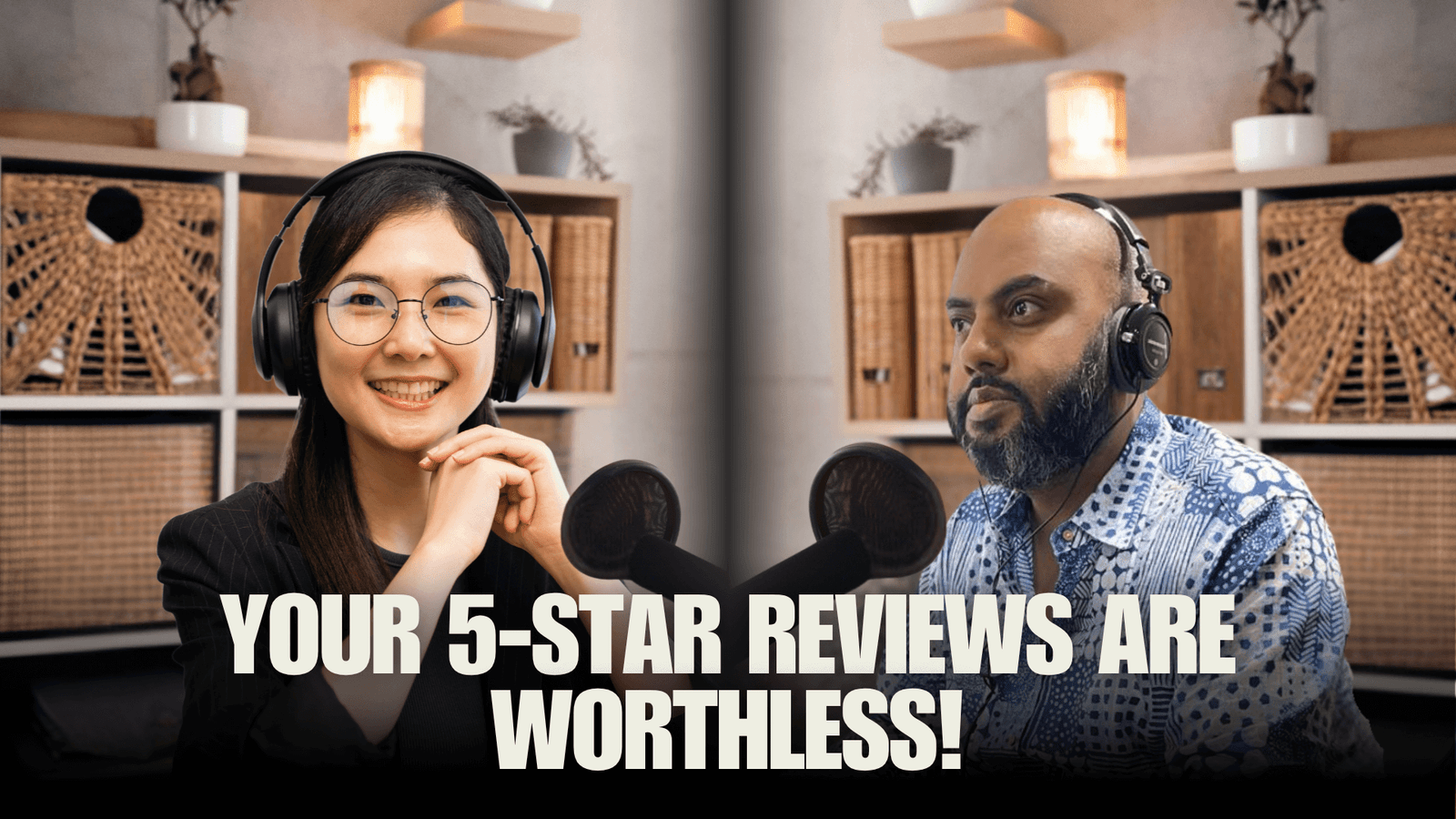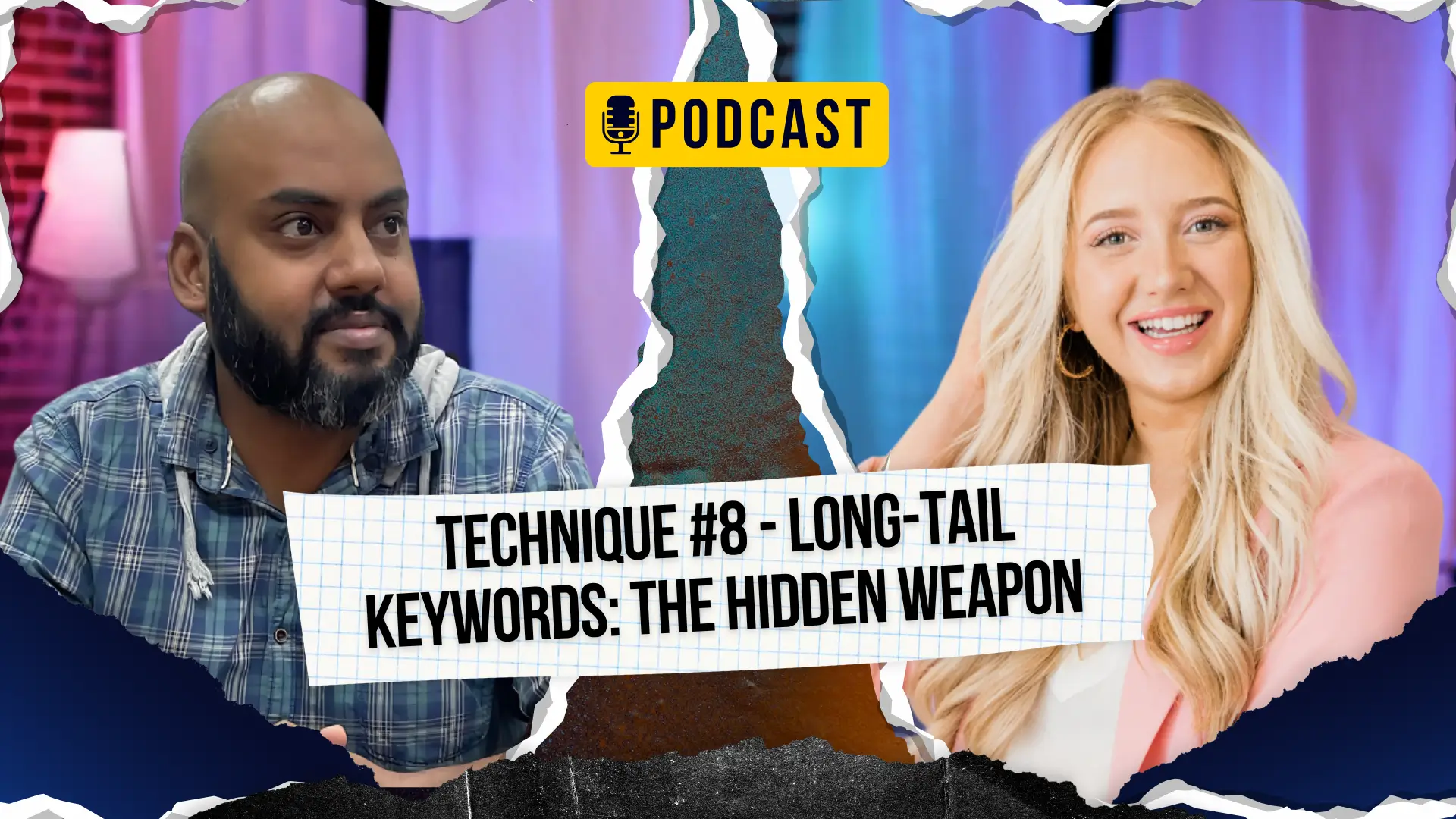Why Readability is the Secret Sauce to Ranking in AI Search

EP#14 Generative Engine Optimization Podcast | Boost AI Visibility
Conquer AI Search With AI
Also available on:
Table of Contents
🎙️ Conquer AI Search – Episode 14: Readability for AI Visibility
Intro & Mission (0:00 – 0:12)
- Meet your hosts and the goal of the show
Why Readability Matters in AI Search (0:13 – 1:36)
- The shift from human-only to AI+human optimization
- The shift from human-only to AI+human optimization
Core Readability Principles (1:37 – 3:03)
- From E-E-A-T to simplicity, clarity, and structure
Writing Tips for GEO Success (3:04 – 5:41)
- Short sentences, active voice, paragraph strategy
- Short sentences, active voice, paragraph strategy
Structuring & Designing for AI (5:42 – 7:07)
- Subheadings, lists, visuals, and white space
- Subheadings, lists, visuals, and white space
Credibility & Citations (7:08 – 9:33)
- Data, sources, and building trust with AI
- Data, sources, and building trust with AI
The Power of Storytelling (9:34 – 10:56)
- Why stories work—even for AI algorithms
Final Takeaways (10:57 – 12:31)
- Readability as the future-proof content strategy
- Readability as the future-proof content strategy
Why Readability is the Secret Sauce to Ranking in AI Search
🧠 “Turns out, the clearer your content, the louder it speaks—to humans and to AI.”
Let’s Talk Readability—Yes, It Matters Now
You’ve probably heard it before: write clearly, write simply.
But here’s the twist… It’s no longer just good advice for readers. It’s now a game-changing strategy for ranking in AI-powered search tools like ChatGPT, Perplexity, and Gemini.
In this episode of Conquer AI Search with AI, Katherine and Avi (that’s us 👋) dive deep into something most marketers still overlook: readability as a ranking factor in Generative Engine Optimization (GEO).
Spoiler alert: it’s more powerful than most technical SEO tactics.
Wait, Isn’t Readability Just a “Nice-to-Have”?
That’s what we thought, too. But according to multiple sources and real-world data, improving how easy your content is to read can boost your AI search visibility by up to 40%.
Why? Because AI systems like those powering Google’s AI Overviews or ChatGPT’s browsing tools aren’t just crunching keywords, they’re understanding your content.
And what do they prefer?
✅ Clear structure
✅ Direct language
✅ Obvious credibility
✅ Bite-sized formatting
They’re trained on human conversation. So, if your content reads like a tangled academic journal? That’s a hard pass for both users and algorithms.
6 Readability Hacks That Make AI and People Love You
Here’s what we broke down on the podcast (in plain English):
1. Keep It Simple (No, Really)
You don’t need to “dumb down” your ideas, but you do need to ditch jargon.
If you must use a complex term, define it immediately. Use examples. Make it sound like you’re explaining it to your smart-but-not-nerdy friend over coffee.
Pro tip: If your content sounds like a robot wrote it… the AI probably won’t trust it.
2. Short Sentences, Short Paragraphs, Big Wins
Long-winded paragraphs? Hard to read. Even harder on mobile. AI notices high bounce rates and assumes your content isn’t helpful.
- Stick to sentences under 20 words
- Keep paragraphs under 100 words
- Focus on one idea per paragraph
- Stick to sentences under 20 words
Bonus: White space makes everything feel cleaner, less intimidating.
3. Say It Straight: Use Active Voice
It’s not just grammar-school advice. Active voice makes content clearer, punchier, and more human.
✅ We published the study.
🚫 The study was published by us.
AI likes sentences that get to the point—and so do readers.
4. Headings and Lists = Structure Heaven
Use headings (H2s, H3s) like road signs. Help readers and AI scan quickly.
Also, bullet points are gold:
- Easier to skim
- Help AI understand information hierarchy
- Easier to skim
Perfect for featured snippets and AI answers
5. Visuals + White Space = Less Brain Burn
Adding images, infographics, or even short videos helps users retain information and stay longer on your site.
Even better? Add transcripts to your videos.
That’s machine-readable content gold.
And don’t underestimate white space (aka the empty space around your text). It makes your content feel clean, premium, and trustworthy.
Think Apple’s website. Or Medium. That’s the vibe.
6. Show Your Work: Cite Sources
Trust is currency in GEO. Back up your claims with stats, credible studies, and expert opinions. And name your sources.
This boosts your EEAT signals (Experience, Expertise, Authoritativeness, and Trustworthiness), which AI uses to decide whether to include your content in its answers.
Real talk: Just adding citations can give your content a 30–40% visibility boost.
Don’t Forget the Power of Story
Yep. Storytelling isn’t just for YouTubers and influencers. Even in B2B content, a little narrative goes a long way.
Use case studies. Share founder lessons. Talk about client wins—or failures. The AI understands narrative structure and human tone. And it prefers it.

Do You Know What ChatGPT is Saying about Your Brand?
Don’t wait for a crisis. Proactively manage your brand’s reputation in the age of AI. To learn what AI is saying about you, book 1:1 Meeting with the #1 GEO Expert in the world.
TL;DR — Your Content Should Be:
✅ Simple and jargon-free
✅ Packed with visuals and spaced out properly
✅ Backed by sources
✅ Optimized for skimming
✅ Human-sounding, with active voice and stories
If your content is easy for a person to understand, it’s easier for AI to rank.
Final Thoughts: This Isn’t Dumbing Down. It’s Smartening Up.
Readability isn’t fluff. It’s a strategy. It’s how you future-proof your GEO, and earn a place in the AI-generated answers that are shaping the next generation of search.
So, whether you’re building a brand blog, writing landing pages, or publishing product docs… the question is:
Can both a person and a machine easily get what you’re saying?
If not, time to rewrite.
🎧 Loved this episode?
Follow Conquer AI Search with AI on Spotify, Apple Podcasts, YouTube, Amazon Music or wherever you get your podcasts. And leave us a review if this helped!
📅 Next Saturday: We’re diving into Technique #7. You won’t want to miss it.
(0:00 - 0:06)
Welcome, everyone, to the Conquer AI Search podcast. We're part of the AI Monitor team, and I'm Katherine. And I'm Avi.
(0:06 - 0:12)
Great to be here. Our mission on this show is pretty simple, really. We want to help you boost your visibility in AI searches.
(0:13 - 0:24)
Right, using straightforward, actionable steps, things you can actually do without needing a huge budget. Exactly. No spending needed for these tips, and, well, we probably shouldn't brag too much.
(0:24 - 0:35)
Oh, here we go. But we were recently named the number one consultants for generative engine optimization by Yes! Users. That was after their big survey with hundreds of SaaS companies, so feeling pretty good about that.
(0:35 - 0:38)
Okay. Okay, a little bragging is allowed. It was well-earned.
(0:39 - 0:54)
We are deep into our 11-episode series now, looking at the most effective ways, you know, the techniques to boost your content's visibility in AI searches. So far, we've covered quite a bit. We've explored implementing those LLMS.txt files, which are, like, super important.
(0:54 - 1:09)
Yeah, the instruction manuals for the AI crawlers, basically. Exactly. And we've looked at leveraging Reddit, using authoritative citations strategically, evolving your whole SEO playbook for this AI era, and the Power PR public relations.
(1:09 - 1:37)
Which was surprisingly critical, wasn't it? It really was. So today, we're plunging into the sixth technique, improving the readability of your content to really boost your visibility in generative engine optimization, you know, sometimes called answer engine optimization, or AEO. Yeah, and what's really fascinating here, and this comes straight from our sources, is how much readability, which, you know, we always thought was for making human readers happy, has now become like a cornerstone for AI search visibility.
(1:37 - 1:49)
It's kind of a paradox. AI systems, they're basically trained on human conversation. So they inherently favor content that's clear, concise, easy for us to process.
(1:49 - 2:00)
Oh, okay. So it's not just about making your stuff sound nice, it's about making it super digestible for those algorithms. The ones powering AI overviews and those little generative snippets we see? Exactly those.
(2:00 - 2:19)
Okay, that's a big shift. So let's unpack this. Why now? For someone maybe deep in technical SEO, why is basic readability suddenly more critical? Especially when AI can supposedly crunch through tons of complex stuff? Well, it's kind of because of that processing power, that clarity matters so much.
(2:19 - 2:30)
Our sources, they really highlight that AI models prioritize content that just screams E-E-A-T. Experience, expertise, authoritativeness, trustworthiness, and transparency, too. And transparency, yes.
(2:30 - 2:42)
So readable content, especially if it's backed up with data, credible sources, that doesn't just signal credibility to a person reading it, it makes it crystal clear to the AI. So the AI picks up on that clarity as a signal. Absolutely.
(2:43 - 2:54)
The studies we looked at even show that making content like deeper, but also clearer, can boost its chances of showing up in AI answers by up to 40%. 40%? Wow. That's a huge number.
(2:54 - 3:03)
Direct link. Okay, so it's not just about the words themselves then, is it? We hear readability and think grammar, sentence structure. Yeah, good point.
(3:04 - 3:16)
It's definitely more than just the writing. The sources emphasize things like website layout, your on-page SEO elements, you know, the usual suspects there. But also how you strategically use things like video or infographics.
(3:16 - 3:21)
Right. Think about it. You could have the most brilliant writing, just genius-level stuff.
(3:22 - 3:32)
But if it's buried in a messy layout or isn't optimized, people will just click away. And now the AI might effectively do the same. And that flags things like bounce rate.
(3:33 - 3:38)
Exactly. Bounce rates go up, search engines and AI see that as a negative signal. Poor user experience.
(3:39 - 3:40)
Right. So it's holistic. We need the whole package.
(3:40 - 3:56)
Okay, so if we want our content easily understood by both humans and AI, where do we start with the writing itself? What's principle number one? Simplicity. That's the word our sources keep hitting. You really have to avoid jargon, those overly complex words.
(3:56 - 4:01)
But what if the topic is complex? You sometimes need the technical terms. Totally. And that's okay.
(4:01 - 4:09)
If you have to use a big word, the rule is define it immediately, like right after you use it. And define it in super simple language. Gotcha.
(4:10 - 4:13)
Like explaining it to someone outside the field. Exactly. Think of it like that.
(4:13 - 4:23)
You want the information delivered efficiently without forcing the AI or the reader to do heavy lifting just to understand the words. Makes perfect sense. So keep it simple.
(4:23 - 4:34)
What about structuring sentences and paragraphs? Any like hard rules there? Yeah, this is where it gets really practical and it taps into psychology and processing. Write short sentences. That's a big one.
(4:34 - 4:46)
How short is short? Well, the general guideline is anything over, say, 20 words starts to feel long. Shorter sentences are just easier to scan, easier to understand, less chance of getting lost. Yes.
(4:46 - 4:54)
And related to that, keep paragraphs short too. Ah, okay. Like how short? Aim for maybe 100 words or less.
(4:54 - 4:58)
And crucially, stick to just one main idea per paragraph. One idea. Okay.
(4:58 - 5:02)
Yeah. This creates white space, breathing room on the page. Yeah.
(5:02 - 5:09)
Makes it feel less intimidating, you know, especially on a phone screen. Yeah. Walls of text are the worst on mobile.
(5:10 - 5:16)
Totally. It gives the eyes and the AI these little pauses to digest the info in chunks. I can see that.
(5:16 - 5:21)
Less cognitive load. Which brings me to active versus passive voice. Classic writing advice.
(5:21 - 5:26)
Still relevant for AI. Oh, absolutely. Our sources are pretty firm on this one.
(5:26 - 5:30)
Stick with active voice whenever you can. Why exactly? It just delivers a clearer message. It's more direct.
(5:30 - 5:34)
The subject does the action. You know, the team analyzed the data. Simple.
(5:34 - 5:41)
Instead of, the data was analyzed by the team. Right. But passive construction is just wordier, a bit more distant.
(5:41 - 5:52)
Now passive voice isn't evil. It has its uses, like in formal science papers or if you don't know who did the action. But generally, active voice is more engaging, more dynamic, more like how people actually talk.
(5:52 - 5:59)
And since AI learns from human conversation. Bingo. It prefers that direct, natural style.
(5:59 - 6:07)
Easier to process, easier to extract meaning from. Okay, makes sense. So simple words, short sentences, short paragraphs, active voice.
(6:08 - 6:15)
What about visually structuring the content beyond just the text? Right. The visual and logical flow. Subheadings are your best friend here.
(6:16 - 6:18)
Okay. Use them generously. Seriously.
(6:18 - 6:26)
They make a huge difference. They break up the text, let readers and AI scan quickly, find what they need, digest info in related chunks. Like signposts.
(6:26 - 6:33)
How should we structure them? Like H1, H2, H3. Yeah, exactly. Think of your H1 as the main title, the book title.
(6:33 - 6:39)
H2s are your main sections, like chapters. And H3s are for subsections within those chapters, drilling down a bit. Got it.
(6:39 - 6:47)
Any guideline on how much text should follow a subheading? Good question. Ideally, keep it manageable. Maybe around 250 to 350 words.
(6:47 - 6:56)
You just want to avoid those long, unbroken walls of text that make people's eyes glaze over. Right. And what about lists? Bullet points, numbered lists? Definitely use them.
(6:56 - 7:07)
Our sources really push these. They break things up visually, again, helping readers rest their eyes and pinpoint info fast. And for the AI? They're great for AI, too.
(7:07 - 7:17)
They help the algorithms understand the structure and hierarchy of your information. Makes it much easier for them to pull out key points for summaries or answers. They're like little structured data points within your text.
(7:17 - 7:23)
Okay. Lists and headings. What about actual visuals, images, videos? And you mentioned empty space earlier.
(7:23 - 7:30)
Yeah, visuals are key. Simple images can be really powerful. They can convey an idea quickly, reduce the mental effort needed from the reader.
(7:30 - 7:49)
And things like images, videos, infographics, they cater to different learning styles. Visual auditory learners, wider reach. And how does AI interact with video, for instance? Well, if your videos are optimized, good titles, descriptions, tags with relevant keywords, and importantly, transcripts.
(7:50 - 7:54)
Transcripts. Yes. Transcripts allow the AI to effectively read the video content.
(7:54 - 8:02)
This boosts discoverability, strengthens those EET signals, makes your content richer, more accessible to the AI. Okay. So optimize everything.
(8:02 - 8:08)
Now, about that white space. Sounds like nothing. Why is nothing important? Yeah.
(8:08 - 8:18)
It sounds weird, doesn't it? But white space, or negative space, is just the intentional empty area around things. It doesn't have to be white, just empty. No text.
(8:18 - 8:20)
No images. Okay. And its purpose.
(8:20 - 8:29)
Its purpose is huge. It gives the eye breathing room, stops the page feeling cluttered or overwhelming. It helps the important stuff, your text, your key images really stand out.
(8:29 - 8:36)
It improves focus. Exactly. Improves focus, improves legibility, reduces that cognitive load we talked about.
(8:36 - 8:39)
Yeah. Makes the whole thing look cleaner, more professional. I was thinking examples.
(8:39 - 8:48)
Think about Apple's website, or Google's homepage, or Medium articles. They use white space brilliantly. It guides your attention, conveys simplicity and clarity.
(8:48 - 8:54)
And AI interprets a clean, user-friendly design as a sign of quality. Fascinating. Okay.
(8:54 - 9:07)
So we've got language, sentence structure, page structure, visuals, even empty space. What else contributes to making content appealing to both readers and AI? Credibility. This came up again and again in the sources.
(9:07 - 9:13)
It's absolutely king, meaning you must back up your points. Use data. Use statistics.
(9:14 - 9:16)
Quote experts. And cite your sources. Yes.
(9:16 - 9:19)
Yes. Cite reputable, authoritative sources. Always.
(9:19 - 9:31)
This builds trust with your human audience, obviously, but it also massively reinforces your EEAT standing with generative AI. How so? Well, think about it. AI models can't just invent facts or stats.
(9:31 - 9:33)
Dang it. Reliable sources. Oh.
(9:33 - 9:45)
So content that provides data and shows its work with citations. That's gold for AI. It makes your content much more likely to be trusted, referenced, highlighted in AI answers.
(9:45 - 9:55)
Our sources mentioned a potential boost from citations alone, didn't they? They did, yeah. Something like a 30-40% increase in AI visibility just by adding robust citations. It signals you've done your homework.
(9:55 - 9:56)
Wow. That's huge. Okay.
(9:56 - 10:04)
One more thing that popped out from the sources. Storytelling. How does telling stories fit into optimizing for AI? Seems counterintuitive for logical machines.
(10:04 - 10:14)
It does seem that way, but it's actually a really smart strategy. The sources call it a superpower. Humans are just wired for stories, right? They grab us, help us connect, help us remember, they add emotion.
(10:14 - 10:25)
And while AI seems purely logical, remember what it's trained on. Human conversation. Billions of examples of human conversation, which is packed with stories, anecdotes, experiences.
(10:26 - 10:33)
Ah, okay. So AI recognizes narrative structure. It understands the patterns and the engagement factor.
(10:34 - 10:46)
Stories, even little ones, make content memorable, more engaging, less dry. You can use them in intros to hook people, use case studies to illustrate points, share your own journey. Client transformations, maybe? Perfect example.
(10:46 - 10:56)
Or even talking about failures and what you learn. It makes your voice authentic. It connects with readers on a human level, and that signals high-quality, valuable, human-like content to the AI.
(10:57 - 11:08)
Content worth paying attention to. This has been incredibly useful, so let's bring it all together. For our audience listening, working on their GEO strategies, what's the big takeaway here? I think the main thing is that improving readability.
(11:09 - 11:23)
It's not just about dumbing things down, not at all. It's about being strategic, crafting your content so both humans and these sophisticated AI models can effortlessly understand it, categorize it, prioritize it. So precision, organization, credibility.
(11:24 - 11:29)
Exactly. Communicating with absolute clarity on every level. That resonates across all forms of search, old and new.
(11:30 - 11:49)
It really does feel like future-proofing your content, doesn't it? And as AI gets even more conversational, more discerning, with multimodal search, querying with images, voice, maybe video. It's evolving fast. How might our whole idea of readability change? What could be the next standard for clear, direct content? Definitely something to think about as you optimize.
(11:52 - 12:05)
That wraps up today's episode of Conquer AI Search. Thanks so much for tuning in. If you enjoyed the conversation, make sure to follow or subscribe wherever you're listening, whether that's Spotify, Apple Podcasts, Audible, Amazon Music, or right here on YouTube.
(12:05 - 12:16)
And hey, if you got value out of this episode, consider leaving a rating or review. It really helps us reach more listeners like you. As you continue to refine your content for the AI search landscape, consider this.
(12:16 - 12:31)
How might improving readability not just help AI understand you, but also strengthen your brand's human connection in an increasingly automated world? See you next Saturday with the 7th AI Optimization or Generative Engine Optimization Technique. Thanks for joining us.
📚 Sources & References
- How can I create my blog so that its readability is optimized? – Reddit
- AI Visibility: What It Means & How to Win It – Writesonic
- AI for Writing: How to Use AI to Write Better Content – Backlinko
- How to Use Headings on Your Site – Yoast
- Free Readability Test Tool – WebFX
- Clear Language: Simple Sentences – Readability Guidelines UK
- Generative Engine Optimization (GEO) Tips – Writesonic
- Voice Search Optimization for 2025 – S4Carlisle
- What is Answer Engine Optimization (AEO)? – GUVI
- SEO vs AEO vs GEO: Key Differences – DataSpace Academy
- AI Content Optimization Case Study – Lionbridge (PDF)
- 10 Plain English Principles for Better Web Writing – Bynder
- How to Write a Blog – Dorik
- Common Blogging Mistakes to Avoid – RightBlogger
- 5 Tips to Improve Readability of Your Blog Post – Yoast
- Blog Readability Tips – Self Made Millennials
- Active vs Passive Voice – Grammarly
- Artificial Intelligence Optimization – Wikipedia
- Research Paper: AI Optimization Techniques – arXiv


 Overcast
Overcast
 Castro
Castro



